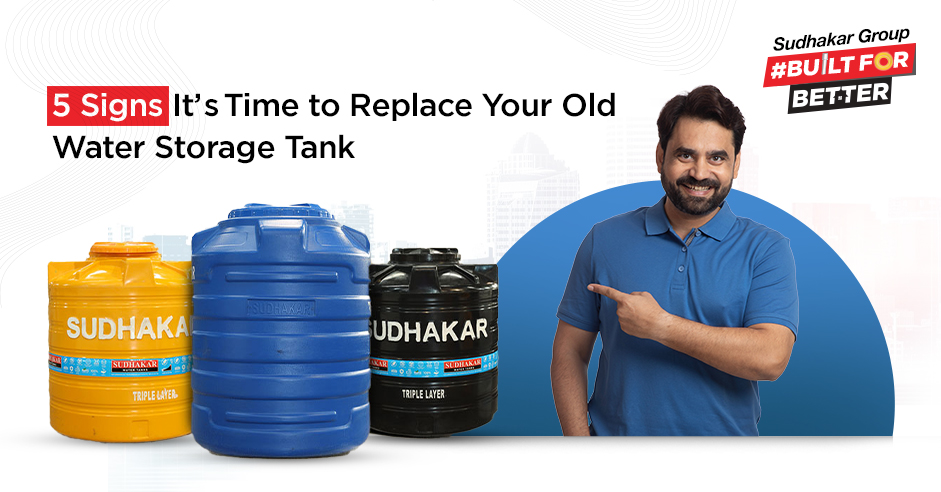Your water storage tank is one of those things you don’t think about until it’s a problem. It sits there quietly, holding the water you drink, cook with, and bathe in. But when it starts acting up, it’s not just a hassle – it can mess with your health and home. Keeping your water tank in good shape is non-negotiable. So, how do you know when to get a new one? Here are five clear signs your water storage tanks are begging for a replacement – and why modern plastic water tanks might be the upgrade you need.
1. Cracks That Spell Trouble
Check your water tank for cracks. Even tiny ones are bad news. A crack means water’s seeping out, and dirt or germs can sneak in. If you spot cracks, that means your tank’s structural integrity is compromised. Old cement or metal water storage containers are especially prone to this – cement erodes, and metal rusts. A cracked tank isn’t just leaking water; it’s risking contamination. Studies show that damaged water storage tanks can harbour bacteria like E. coli, making you sick. Modern plastic water tanks, made from tough materials like HDPE, resist cracking way better. If your tank’s looking like a jigsaw puzzle, it’s time to swap it out.
2. Discolouration That Raises Eyebrows
Ever noticed your water tank’s insides turning yellow, brown, or just weird? Discolouration often comes from rust in metal tanks or chemical breakdown in old plastic ones. It’s a sign the material’s degrading, and that gunk can end up in your water. Drinking or cooking with tainted water is a health risk. Newer plastic water tanks come with UV-resistant and food-grade coatings to prevent this. If your tank’s changing colours faster than a chameleon, don’t wait – replace it.
3. A Funky Odour You Can’t Ignore
Open your water tank and take a whiff. Smell something off, like mould or chemicals? That’s your water storage containers screaming for retirement. Foul odours mean bacteria, mould, or chemical leaching from the tank’s material. This is common in older tanks that weren’t built with food-safe plastics. Modern plastic water tanks are designed to endure without putting the water quality at risk.
4. Leaks That Waste Water and Patience
A dripping water tank is more than annoying – it’s a waste. Leaks can come from cracks, loose fittings, or plain wear and tear. Even small ones add up. Leaks also attract pests and create damp spots that breed mosquitoes, causing dengue risk. If your water storage containers are springing leaks, patching them is a band-aid fix. Plastic water tanks today come with seamless designs and tougher builds, so leaks are less likely. Spot a drip? Start shopping for a replacement.
5. Algae Growth That’s Out of Control
Green slime inside your water tank isn’t a science experiment – it’s algae. This happens when sunlight sneaks into the tank, usually through a transparent or thin lid, and feeds tiny organisms in the water. Algae doesn’t just look gross; it can clog pipes and make water unsafe. In rural India, where open or poorly covered water storage tanks are standard, algae is a big issue. Plastic water tanks now have opaque, UV-blocking layers and tight lids to keep sunlight out. If you’re scraping green gunk off your tank’s walls, it’s past its prime. Swap it for something that keeps algae at bay.
How to Spot the Signs Early
Don’t wait for your water tank to completely fall apart. Make it a habit to check your water storage containers every few months. Climb up to the roof or wherever your tank sits. Look for cracks or leaks. Sniff for weird smells. Peek inside with a flashlight for algae or discolouration. Catching these issues early can save you from a replacement rush. If your tank’s over 10-15 years old – common for cement or early plastic models – it’s time to start budgeting for a new one before things go south.
What to Look for in a New Tank
When you’re ready to replace your water storage tanks, don’t just grab the cheapest option. Look for plastic water tanks with a solid warranty – 5-10 years is standard. Check if they’re food-grade and BIS-certified (IS 12701 is the gold standard in India). Make sure the tank’s got a sturdy lid to block sunlight and debris. Size matters too – pick one that fits your household’s needs. A family of four in a city flat might need a 500-1000-litre water tank, while rural homes with bigger plots might go for 2000 litres or more. Ask the seller about UV protection and anti-microbial layers for extra peace of mind.
Wrap Up
Next time you’re fetching a bucket of water, give your tank a quick once-over. Those five signs don’t lie – listen to them, and you’ll keep your water flowing clean and steady for years.


